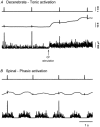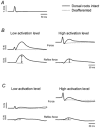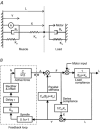Stretch reflex gain in cat triceps surae muscles with compliant loads
- PMID: 12482905
- PMCID: PMC2290714
- DOI: 10.1113/jphysiol.2002.027177
Stretch reflex gain in cat triceps surae muscles with compliant loads
Abstract
The triceps surae (TS) stretch reflex was measured in decerebrate cats during crossed extensor stimulation (tonic contractions) and after spinalization during rhythmic locomotor activity. The TS reflex force in response to a short pulse stretch measured during tonic contractions at low level of background activity was greater than when more background activity was present at the time of application of stretch. In contrast, the reflex force measured during rhythmic contractions was very small at low level of background force (flexion phase) and increased at moderate and high levels of background activity (extension phase). Thus, even in reduced preparations, a task modulation of the stretch reflex occurs. Throughout the experimental procedure, the torque motor used to stretch the muscles behaved like a spring of a preset compliance (from isometric to very compliant). A reflex model was used to simulate the responses obtained experimentally. The gain of the stretch reflex loop was estimated for each load condition and both behavioural tasks. The reflex loop gain was significantly larger as the compliance of the external load increased for both tonic and rhythmic contractions, although to a lesser extent in the phasically activated muscles. During rhythmic locomotor contractions the gain was less than 1, assuring stability of the system. In contrast, during tonic contractions against a compliant load the gain exceeded 1, consistent with the instability (oscillations, clonus) seen at times under these load conditions. However, the high gain and instability was only transient, since repeated stretch reduced the gain. Thus, non-linearities in the system assured vigorous responses at the onset of perturbations, but then weaker responses to ongoing perturbations to reduce the chance of feedback instability (clonus).
Figures








Similar articles
-
Gain of the triceps surae stretch reflex in decerebrate and spinal cats during postural and locomotor activities.J Physiol. 1996 Nov 1;496 ( Pt 3)(Pt 3):837-50. doi: 10.1113/jphysiol.1996.sp021731. J Physiol. 1996. PMID: 8930848 Free PMC article.
-
Stretch and H reflexes in triceps surae are similar during tonic and rhythmic contractions in high decerebrate cats.J Neurophysiol. 2000 Apr;83(4):1941-50. doi: 10.1152/jn.2000.83.4.1941. J Neurophysiol. 2000. PMID: 10758105
-
Recruitment of triceps surae motor units in the decerebrate cat. II. Heterogeneity among soleus motor units.J Neurophysiol. 1996 May;75(5):2005-16. doi: 10.1152/jn.1996.75.5.2005. J Neurophysiol. 1996. PMID: 8734599
-
Mechanical and electromyographic stretch responses in spastic and healthy subjects.Acta Neurol Scand Suppl. 1995;163:1-24. Acta Neurol Scand Suppl. 1995. PMID: 7484084 Review.
-
Sensory control of locomotion: reflexes versus higher-level control.Adv Exp Med Biol. 2002;508:357-67. doi: 10.1007/978-1-4615-0713-0_41. Adv Exp Med Biol. 2002. PMID: 12171131 Review.
Cited by
-
Enhancing KCC2 activity decreases hyperreflexia and spasticity after chronic spinal cord injury.Exp Neurol. 2021 Apr;338:113605. doi: 10.1016/j.expneurol.2021.113605. Epub 2021 Jan 13. Exp Neurol. 2021. PMID: 33453210 Free PMC article.
-
Control of dynamic foot-ground interactions in male and female soccer athletes: females exhibit reduced dexterity and higher limb stiffness during landing.J Biomech. 2014 Jan 22;47(2):512-7. doi: 10.1016/j.jbiomech.2013.10.038. Epub 2013 Nov 7. J Biomech. 2014. PMID: 24275440 Free PMC article.
-
Reflex responsiveness of a human hand muscle when controlling isometric force and joint position.Clin Neurophysiol. 2007 Sep;118(9):2063-71. doi: 10.1016/j.clinph.2007.06.009. Epub 2007 Jul 23. Clin Neurophysiol. 2007. PMID: 17646129 Free PMC article.
-
Time to task failure varies with the gain of the feedback signal for women, but not for men.Exp Brain Res. 2006 Oct;174(3):575-87. doi: 10.1007/s00221-006-0498-3. Epub 2006 May 6. Exp Brain Res. 2006. PMID: 16680423
-
Muscle activity differs with load compliance during fatiguing contractions with the knee extensor muscles.Exp Brain Res. 2010 Jun;203(2):307-16. doi: 10.1007/s00221-010-2233-3. Epub 2010 Apr 1. Exp Brain Res. 2010. PMID: 20358188
References
-
- Allum JHJ, Mauritz K-H. Compensation for intrinsic muscle stiffness by short-latency reflexes in human triceps surae muscles. Journal of Neurophysiology. 1984;52:797–818. - PubMed
-
- Bässler U. Neural Basis of Elementary Behavior in Stick Insects. Berlin: Springer-Verlag; 1983.
-
- Bawa P, Mannard A, Stein RB. Effects of elastic loads on the contractions of cat muscles. Biological Cybernetics. 1976a;22:129–137. - PubMed
-
- Bawa P, Mannard A, Stein RB. Predictions and experimental tests of a visco-elastic and inertial loads. Biological Cybernetics. 1976b;22:139–145. - PubMed
Publication types
MeSH terms
LinkOut - more resources
Full Text Sources
Miscellaneous

